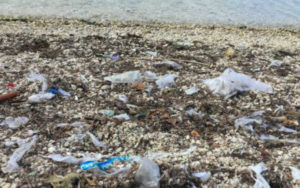
25 February 2016
During the past year, the media has been talking more and more about plastics in the ocean due to new research reports. Plastic materials make many things possible in our day-to-day lives. However, plastic waste in the ocean has many negative impacts. This is the first of a three-part series to look at the size of the problem, the impacts, and the solutions.
How Much Plastic Goes into the Ocean?
A lot.
About 8.7 million metric ton – or 8,700,000,000 kg – or 19,180,218,360 lbs.
This number got everyone’s attention last year when a group of researchers published their study in Science. It is a number based on solid calculations using data from 2010. It is a conservative figure because it does not include all of the sources of plastic waste. And that is the amount today.
Tomorrow it will get worse. It is a simple function of population growth and the increasing use of plastics which will result in the growth of plastic waste.
150 million metric ton in 2025 is the mid-range estimate. The only thing that can stop that growth is a big improvement in waste collection. Infrastructure improvements are needed in key developing countries where incomes are rising, lifestyles are changing, and waste collection has not kept up.
Where Does It Come From?
The study in Science looked at land-based plastic waste meaning the waste came from the land into the ocean. The sources they considered were litter (throwing trash on the ground or in water) and “mismanaged” waste such as dumping or uncontrolled landfills.
Countries with the most plastic waste going into the ocean in their study were:
1) China
2) Indonesia
3) Philippines
4) Vietnam
5) Sri Lanka
6) Thailand
7) Egypte
8) Malaysia
It is interesting to note that all of these countries have important fisheries industries, and most of them have important tourism economies.
Other land-based sources are controlled landfills but with borders that allow trash to get into the ocean (wind, flooding, etc.) Some plastics pass through the sewer system. Cyclones, tsunamis, floods, tornados all carry plastic building materials and waste into the ocean.
Almost 20% of plastic waste is marine-based meaning it came from fishing boats, ferries, cargo vessels, oil platforms, etc. Although international treaties make it illegal to dump trash into the ocean, it still happens.
What Kinds of Plastics Waste Are Found in the Ocean?
One source with visible negative impacts is ghost fishing equipment. Boat lines, fishing nets, traps, and fishing line that are “lost” can float free in the ocean for a long time. Adrift for years even decades, they continue to trap and kill marine animals, fish and crustaceans.
Visit any beach and you will find plastics. The greatest amount of waste (by item) found during beach clean-ups around the world were the following:
1) Cigarette Butts
2) Plastic Food Wrappers
3) Plastic Water & Beverage Bottles
4) Bottle Caps
5) Straws and Stir Sticks
6) Other Plastic Bags
7) Plastic Grocery Bags
8) Glass Bottles
9) Beverage Cans
10) Plastic Cups & Plates
(Data: Ocean Conservancy, 2015 Report.)
These are macroplastics – big pieces that can be seen easily.
Microplastics – plastic pieces that are smaller than 5mm – are now “seen” as great environmental risk. Microplastics include particles from “biodegradable” plastics and other plastics breaking down slowly in the ocean. They also come from municipal sewer systems. The sources are fibers from washing clothes made of artificial fabrics and plastic beads used in face scrubs and toothpastes.
Between 15 and 51 trillion particles have accumulated in the ocean according to a study just published in the Environmental Research Letters in December of last year. Measured by weight, it is only about 1% of the global plastic waste going into the ocean each year, but the number of particles makes it a very big problem.
Where Does It Go?
Everywhere.
You see it covering the beaches. You see it floating in the water. Divers see it wrapped around corals on the reefs. Sailors and researches find it swirling in five gyres – places in the ocean where currents and winds cause plastics to accumulate. It is also on the sea floor. It is in deep-sea sediment. It is in artic ice.
How long does plastic last? What is its impact? What can be done? Answers to those questions can be found in the next two issues of this newsletter.
